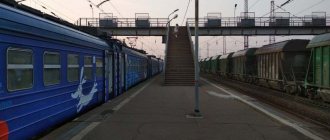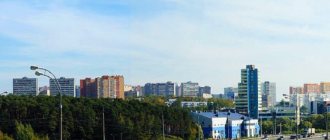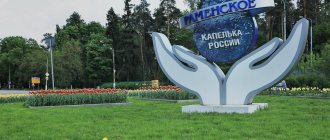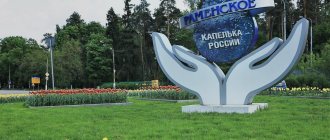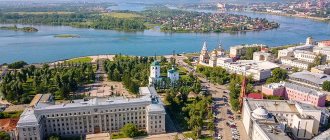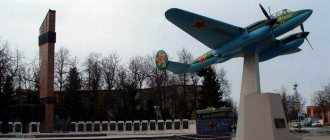History of the territory of Balashikha until the 16th century
On the territory of modern Balashikha, archaeologists have recorded traces of settlements dating back to the 7th century BC. On the banks of the Gorenka and Pekhorka rivers they discovered burials and places of sacrifice. Traces of the presence of the Slavs here date back to the 10th century, thanks to the discovery of mounds erected by East Slavic tribes at burial sites. There are about 350 such mounds and their traces in the vicinity of Balashikha. Based on the characteristic features of household items, archaeologists can confidently say that these mounds were erected by the Krivichi and Vyatichi tribes, mentioned in the most ancient Russian chronicles.
On the left bank of Pekhorka, archaeologists discovered a settlement dating back to the 12th-14th centuries. Historians suggest that it was the location of one of the administrative centers of the Moscow Principality during the era of its formation. On the right bank of the Pekhorka, at its confluence with the Gorenka, archaeologists explored a rich settlement of the 12th-14th centuries. In the XIV-XVIII centuries it belonged to the rich boyar family of the Akatovs.
The spiritual letter of Ivan Kalita, who occupied the Moscow Grand Duke's throne, dating back to 1336, has been preserved. It mentions the Pokhryan camp. This is the first mention of the Pokhryanskaya volost, which became the predecessor of Balashikha.
Soon after the Battle of Kulikovo in 1380-1381, Kalita's grandson Dmitry Donskoy concluded a deal to exchange princely lands with the Chudov Monastery, as a result of which the northern part of the Pokhryansk volost became the monastery's property.
In the Scribe books of 1573-1574, information was found about a water mill in the village of Osteevo, which belonged to the Chudov Monastery. But apparently, already in the last years of the 17th century this village ceased to exist. Zarechnaya Street currently runs in this place in Balashikha.
Hotels
Numerous hotels offer city guests to stay in their apartments.
Hotel "Sirenevaya"
The hotel is located at: Balashikha, st. Sirenevaya, house No. 15. The cost of hotel rooms starts from 1.5 thousand rubles. per night. Pets are allowed at the hotel for an additional fee. The hotel has 30 rooms in total.
The hotel has:
- non-smoking rooms;
- parking and the ability to pay by card;
- cafe and internet;
- room service and refrigerator;
- 24-hour front desk;
- laundry and barbecue;
- TV in the rooms and washing machine.
Guest House "On Trubetskoy"
The guest house is located in Balashikha, on the street. Trubetskoy, in house No. 1 “a”. The cost of rooms in a guest house starts from 1.8 thousand rubles. The 2* guest house has only 15 rooms.
The guest house offers amenities and services:
- free parking and internet;
- meeting room and refrigerator;
- non-smoking rooms;
- laundry and barbecue;
- safe and 24-hour reception;
- transfer and shared kitchen;
- TV in rooms and terrace;
- combined rooms.
Hotel Adonis
The hotel is located at: Balashikha, st. Pushkinskaya, house No. 21. The hotel has only 48 rooms. The cost of hotel rooms starts from 1.4 thousand rubles.
The hotel has:
- parking and swimming pool;
- room conditioning;
- gym and restaurant;
- laundry and dry cleaning;
- sauna and banquet hall.
Hotel "Pekhorskaya"
The hotel is located in Balashikha, on the street. Pekhorskaya, in house No. 9. The cost of hotel rooms starts from 1.7 thousand rubles. The 1* hotel has only 20 rooms.
The hotel has:
- car rental service;
- swimming pool and parking;
- fireplace and games room;
- terrace and restaurant;
- non-smoking rooms;
- kitchen corner and TV;
- sauna and barbecue;
- ski storage space;
- beauty salon and pool bar;
- expedited guest registration.
Hotel Artiland
Hotel location: Balashikha, Novskoe highway, building No. 10. Room rates from 8.6 thousand rubles. The hotel has only 9 rooms.
The hotel offers:
- swimming pool and parking;
- room conditioning;
- gym and restaurant;
- refrigerator and laundry;
- 24-hour front desk;
- Jacuzzi and beauty salon;
- barbecue and safe;
- children's playground and massage services;
- terrace and children's pool;
- luggage storage and soundproofed rooms;
- TV in rooms and transfer;
- babysitting services and cafe.
The hotel offers sports opportunities:
- ride horses;
- play table tennis;
- do water sports.
History of the environs of Balashikha in the 17th-18th centuries
Balashikha was first mentioned in written documents at the end of the 16th century. By the beginning of the 17th century, it had already become a large village, in which several neighboring settlements merged.
Like many other cities and villages during the Time of Troubles at the beginning of the 17th century, Balashikha fell into disrepair. But after the accession of the Romanov dynasty in 1613, a new life began in it. The Izmailovskaya volost was created. There are forest hunting grounds on both sides of the road. Many water mills appeared along the banks of reservoirs. The rich village of Pehra-Pokrovskoye grew. It was owned by the Epiphany Monastery. During the reign of Catherine II, it was transferred to the state treasury at the disposal of the College of Economics.
In 1800, Moscow merchants Gerasim and Nikita Petrov founded a silk factory in Balashikha. Women's scarves produced at the factory, decorated with gold and silver and embroidery, were sold at fairs at a huge price, comparable to the average annual income of an ordinary tiller. They were bought by wealthy peasants and representatives of the merchant and noble classes.
Downstream Pekhorka, the Gushchinka water mill has been operating since 1760. A small village named Gushchinka was formed near it. Later, the name of Susanna Beer, who belonged to the merchant class, was attached to this name, since she owned this mill. And the village began to be called Susanovo-Gushchino.
The history of the village of Pehra-Yakovlevskoye can be traced back to the 16th century. For almost two and a half centuries it was the property of the Golitsyns, one of the most noble princely families in Russia. In 1764-1773, Pyotr Golitsyn, who rose to the rank of general, ordered the construction of a park and garden to begin. His son Mikhail began building a real palace on the estate in 1782. The work on the arrangement of this park and palace ensemble was led by eminent architects Karl Blank and Adam Menelas. The Church of the Savior of the Image Not Made by Hands was built on the territory of the estate. (Currently, worship services have been resumed there.)
During all these large-scale construction works, a brick factory was opened on the estate. In addition, a stud farm was founded. In addition to this village, the Golitsyns also owned the nearby village of Leonovo.
The Scribe books also contain information about the village of Chizhovo, located on the banks of the Gorenka River. The first mentions of it date back to 1576-1578. Next door, in 1640, boyar Nikifor Pleshcheev-Chermny organized the construction of the village of Gorenki, choosing for this the wasteland on the left bank of the Gorenki River. In it in 1693, Prince Yuri Khilkov built a landowner's estate, which in 1707 served as a dowry for his daughter Praskovya. She married Prince Alexei Dolgorukov, and in 1724 he, having united Chizhevo and Gorenki in his domains, began the construction of the palace.
In 1747, the entire estate was bought by Alexey Razumovsky, the favorite of Empress Elizabeth, with whom she secretly married. After the death of Razumovsky, his nephew and namesake became the owner of Gorenok. He ordered a major reconstruction of the palace, entrusting the design work to the architect Menelas. As a result, a luxurious park and garden ensemble with a chain of ponds was created. It had a unique greenhouse and a botanical garden with a collection of rare plants exceeding 7 thousand species. Subsequently, it was moved to the botanical garden at Moscow University.
What to see for tourists
You can take a walk around the noble estate located in the city of Balashikha at any time, admission is free. You can see up close the once luxurious noble estate, built more than two and a half centuries ago, as well as such interesting objects as:
- Pond "Saucer". Previously, the main staircase from the mansion, which was decorated with eagles, led to the pond, but over time these decorative elements disappeared. Today, eagles can only be seen in photographs of the Gorenki estate in Balashikha, which helps to imagine the former splendor of the count’s estate.
- Grotto. The semi-underground structure includes a domed room and three narrow winding corridors, one of which leads to a pond. No one knows for sure what purpose this cave was used for - as a cellar or for the privacy of lovers.
- Ruins of the palace colonnade.
Time flies by in this unique place, don’t forget to bring something to eat and a camera; here you can take beautiful photos against the backdrop of historical sites.
Textile factory and other pre-revolutionary enterprises of Balashikha
The history of the city of Balashikha dates back to 1830, in which Prince Trubetskoy, together with the merchant Pavel Moloshnikov, began building a small cloth factory. At first it was located in a wooden building built on the site of a water mill. In 1846, Pavel Moloshnikov re-equipped the factory, and it began to produce cotton textiles. The main production is located in a five-story brick building.
By 1850, the factory employed more than 500 workers and produced more than 5,000 pounds of yarn per year, which brought the owners about 130 thousand rubles of annual income. In 1850, the factory was equipped with a steam engine purchased from Great Britain. For its installation and operation, the English engineer Michael Lunn arrived in Balashikha, who remained the technical director of the factory for 45 years. In 1873, he became one of the co-founders of the Balashinskaya Manufactory Partnership. His companions were merchant manufacturers Mikhail Shcheglov, Pavel Shelaputin and Ivan Karzinkin. Two years later, the enterprise's fixed capital reached 600 thousand rubles. The number of workers in 1879 exceeded 900 people, in 1890 it amounted to 2,687 people, and in 1903 more than 3,000 people worked at the factory.
Gradually a factory village emerged. Its architectural appearance was finally formed in 1907-1910.
By the time the First World War began, the factory and the village of Balashikha had turned into a complex and branched economic organism, on the territory of which, in addition to production facilities, there were barracks-type dormitories for workers, a hospital facility, an elementary school and a workers' college, an almshouse, a railway station, a post office and a telegraph office. A power transmission line ran from Bogorodsk to Balashikha. And peat mining was carried out around Lake Biserova, supplying the factory steam engines with fuel.
In 1821, merchant Ivan Chetverikov founded a cloth factory nearby. Its production volumes in the first decades were very small. By the middle of the century, it employed 92 people. In 1903, it belonged to the Trading House of I.F. Petrov and I.V. Shcheglov, and there were 355 employees. In 1907, the factory was seriously damaged by a major fire. In 1908, a new building and water tower were erected. The architect Ivan Pozdeev worked on their project. Since 1903, he was the architect of the Cathedral of Christ the Savior in Moscow.
Where previously there was a water mill in the village of Gushchinka, at the beginning of the 20th century, manufacturer Alexander Pimenov founded a small enterprise that produced artificial sheepskin.
Weather, best time to travel
The town of Balashikha, located near Moscow, has a moderate cold climate with high rainfall. The average annual air temperature is +4.8°C. The average annual precipitation is 664 mm.
Average climatic indicators in Balashikha:
| month | average temperature | temperature minimum | temperature maximum | precipitation rate |
| January | -9,6 | -12,6 | -6,5 | 41 |
| February | -8,4 | -11,8 | -4,9 | 33 |
| March | -2,9 | -6,4 | +0,7 | 32 |
| April | +5,9 | +1,5 | +10,3 | 42 |
| May | +12,7 | +7,4 | +18,0 | 50 |
| June | +16,8 | +11,6 | +22,0 | 75 |
| July | +18,4 | +13,5 | +23,4 | 90 |
| August | +16,7 | +11,9 | +21,5 | 73 |
| September | +11,1 | +7,0 | +15,3 | 62 |
| October | +4,9 | +1,9 | +7,9 | 60 |
| november | -1,8 | -4,0 | +0,5 | 55 |
| December | -6,4 | -9 | -3,8 | 51 |
Dacha villages
When laying a railway track from Moscow to Nizhny Novgorod near Balashikha in 1863, a stop called Saltykovka was built. Because the initiator of its construction was Prince Pyotr Saltykov.
After the organization of railway communication, rapid construction of country houses and dachas began. One of the dacha villages was named Novo-Sokolniki. The neighboring village, in which mainly railway workers lived, was named Saltykovka, after the name of the stop. At the end of the 19th century, both of these settlements merged and were then called Saltykovka.
In 1893, a large plot of land in the vicinity of Balashikha was acquired by landowner N. N. Kovalev. He ordered clearings to be cut in the forest, divided the territory into small plots and sold them for dacha development. Such transactions with land near Moscow, reminiscent of wholesale purchases and retail sales, brought in solid income in those days.
The village of Saltykovka in the last quarter of the 19th century began to enjoy great popularity among people of intelligent professions who settled there for the summer. Many famous writers and journalists, scientists and public figures, actors and artists settled here. For some time, the unsurpassed landscape artist I. I. Levitan lived in Saltykovka.
How to navigate
There are several public transport routes throughout the city. There are 67 city bus routes, 91 passenger gazelle routes and 10 electric train routes. The cost of travel on public transport in Balashikha is from 35 rubles. up to 40 rub.
The sights of Balashikha have historical architectural significance. Along with them, the city has a huge number of plants, factories and research institutes. The scientific-industrial complex and the socio-economic position of the city occupy a significant position in the country.
Author: Olga Zhanskaya
Soviet period
After the revolution of 1917, with a new territorial and administrative division in 1918, Balashikha became part of the Razinsky district of the Moscow province. In 1920, it was second in the region in terms of the number of operating industrial enterprises. In 1921, two orphanages were created in Balashikha, which housed mainly children from the Volga region. In addition, in Gorenki there was also a children's colony for street children. In 1925, it was repurposed as an anti-tuberculosis sanatorium. In 1928, Balashikha received the status of a workers' village, which, after changes in the administrative division in 1929, was located in the Reutovsky district. At that moment, Balashikha was almost twice as large as Reutovo in terms of population. But the largest factory in terms of number of employees operated in Reutovo.
After the leadership of the USSR set a course for accelerated industrialization, in 1932 the government adopted a decree on the construction of aviation and other military factories in the vicinity of Balashikha. Among other military equipment, retractable aircraft landing gear was produced in Balashikha. The first of the military factories was put into operation in 1937. An airfield was equipped near the village of Chernoye for testing aircraft and other tasks.
Since 1935, the construction of the first residential brick multi-storey buildings began in Balashikha. The textile industry continued to develop rapidly, and both production volumes and the number of jobs increased.
In 1939, Balashikha received the status of a city, the center of the district was moved to it, and the district was renamed from Reutovsky to Balashikha.
The palace and park complex today
In the past, the most picturesque and rich estate is today gradually being destroyed and falling into disrepair: the photo of the Gorenki estate in Balashikha shows that the facade of the three-story building has been put in order, but on the reverse side there is devastation.
The park has been preserved only partially, four of the seven ponds have been lost, and only two bridges remain. Many trees have been cut down, and there is no trace of the fountains and gazebos. The colonnade is overgrown with bushes.
In mid-March 2022, the Red Rose tuberculosis sanatorium, which had been operating in the city of Balashikha for 95 years, was closed.
Years of the Great Patriotic War
During the war years, more than 20 thousand residents of Balashikha went to the front. More than 3,400 of them fell in battle or died from wounds, and more than 4,200 were missing. In July 1941, a people's militia battalion was formed in the Balashikha region. Major Nikolai Kazakov was assigned to command them. On July 31, this battalion, as part of the 2nd Moscow People's Militia Division, entered its first battles. Almost the entire division's personnel died, being surrounded near Vyazma and continuing to fight without receiving reserves, ammunition or food.
More than 8 thousand people from the civilian population of Balashikha in 1941 worked on the construction of defensive fortifications near Moscow.
The Balashikha military factories were evacuated to Kamensk-Uralsky, Nizhny Tagil, Kazan and Kuibyshev. There, the teams of these evacuated enterprises put them into operation as soon as possible. During the war years, they produced 10 times more military products than in Balashikha in the pre-war years.
The ammunition plant was not evacuated and continued its work. In 1943, an armored tank repair plant began operating in Balashikha. After the war, it was repurposed as a truck crane factory.
In order to produce liquid oxygen for military needs, the installation of appropriate equipment was resumed in Balashikha in 1944. Academician Pyotr Kapitsa supervised this work. The first production was obtained in October 1944 using the world's largest installation.
The cotton spinning and cloth factories not only continued to operate after the outbreak of the war, but were also among the few light industry enterprises in the region that managed, even in the most difficult conditions of wartime, when a significant part of the personnel was mobilized into the army, to continue to regularly fulfill the plan for all main assortment indicators .
Recommendations
Notes
- ^ a b c d f
Law No. 11/2013-OZ - ^ a b Encyclopedia of Russian Cities
. Moscow: Great Russian Encyclopedia. 2003. p. 35. ISBN 5-7107-7399-9. - ^ a b c d
Law No. 208/2014-OZ - ^ a b
Federal State Statistics Service of Russia (2011).
“All-Russian Population Census 2010. Volume 1" [All-Russian Population Census 2010, vol. 1]. All-Russian Population Census 2010 [All-Russian Population Census 2010]
(in Russian). Federal State Statistics Service. - https://www.msko.gks.ru/wps/wcm/connect/rosstat_ts/msko/resources/c7954d80450b9e608f41afde4cdebdf4/Estimation+of+the+resident+population+of+the+Moscow+region+by+status+on+1+January+ + g .doc.
- "On the calculation of time." Official Internet portal of legal information
(in Russian). June 3, 2011. Retrieved January 19, 2022. - Post office. Information and computing center of OASU RPO. ( Post office
).
Search for postal facilities ( Search for postal facilities
) (in Russian) - Federal State Statistics Service of Russia (May 21, 2004). “The population of Russia, the constituent entities of the Russian Federation as part of federal districts, urban settlements, urban settlements, settlements, settlements of 3 thousand or more people.” [Population of Russia, its federal districts, constituent entities of the Federation, districts, urban settlements, rural settlements - administrative centers and rural settlements with a population of more than 3000 people] (XLS). All-Russian Population Census of 2002 [All-Russian Population Census of 2002]
(in Russian). - “All-Union Population Census of 1989. The current population of union and autonomous republics, autonomous regions and districts, territories, regions, urban settlements and rural district centers” [All-Union Population Census of 1989: current population of union and autonomous republics, autonomous regions and districts, territories, regions, districts, urban settlements and villages that are district administrative centers]. All-Union Population Census of 1989 [All-Union Population Census of 1989]
(in Russian).
Institute of Demography of the National Research University: Higher School of Economics [Institute of Demography of the National Research University: Higher School of Economics]. 1989 - via Demoscope weekly
. - Toponymy of Balashikha.
- Balashikha. Official page. Story.
- https://www.rusbandy.ru/season/322/
- https://translate.google.co.uk/translate?hl=en&sl=ru&u=http%3A%2F%2Fwww.rusbandy.ru%2Fnews%2F11118%2F
- [1]
- Bellingcat Investigations Team (February 17, 2022). ""V "For" Pennant ": Secret Directorate of the FSB" V "For the murder of a Georgian asylum seeker in Germany." bellingcat. Most often, Krasikov visited the highly guarded FSB Special Operations Center in Balashikha, a suburb of Moscow. This heavily guarded facility, known as military unit 35690, was the original military base for the KGB special forces unit Vympel, and now serves as the headquarters for the FSB Central Investigation Department, as well as the base for the elite and secret departments V and A.
- “Sergey Yurov created a group to work with sister cities.” balashiha.ru
(in Russian). Balashikha. September 9, 2022. Retrieved February 4, 2020. - “Balashikha and Chinese Yangzhou will cooperate in economics and culture.” balashiha.ru
(in Russian). Balashikha. April 13, 2022. Retrieved February 4, 2020.
Sources
- Moscow Regional Duma. Law No. 11 / 2013-OZ of January 31, 2013 “On the administrative-territorial structure of the Moscow region,” as amended. Law No. 249 / 2019-OZ of November 29, 2022 “On amendments to the Law of the Moscow Region” On the administrative-territorial structure of the Moscow Region “”. Came into force the day after official publication (January 13, 2013). Published: “Daily News. Moscow Region,” No. 24, February 12, 2013 (Moscow Regional Duma. Law No. 11/2013-OZ of January 31, 2013. On the administrative-territorial structure of the Moscow Region.
As amended by Law No. 249/2019-OZ of November 29, 2019.
On amendments to the Law of the Moscow Region “On the administrative-territorial structure of the Moscow Region.”
Valid from the day following the day of official publication (January 13, 2013).
- Moscow Regional Duma. Law No. 208 / 2014-OZ of December 30, 2014 “On the transformation of the Balashikh urban district and the Zheleznodorozhny urban district, on the status and establishment of the boundaries of the newly formed municipality,” as amended. Law No. 52 / 2015-OZ of April 13, 2015 “On amendments to the Law of the Moscow Region” On the transformation of the Balashikha urban district and the Zheleznodorozhny urban district, on the status and establishment of the newly formed municipality “”. Came into force 10 days after the official announcement, with the exception of Articles 4 and 5, which come into force one month after the entry into force of this law in the absence of residents of the city of the Balashikha District to hold a local referendum on key structures of local government bodies of the Balashikha Urban District. Published: Official Internet portal of the Government of the Moscow Region (https://www.mosreg.ru), December 30, 2014 (Moscow Regional Duma. Law No. 208/2014-OZ of December 30, 2014. On the transformation of the Balashikha urban district and Zheleznodorozhny urban district, on the status and border of the newly formed municipality
As amended by Law No. 52/2015-OZ dated April 13, 2015
On amendments to the Law of the Moscow Region “On the transformation of the Balashikha urban district and the Zheleznodorozhny urban district, on the status and boundaries again formed municipal entity"
. Valid from the day that is 10 days after official publication, with the exception of Articles 4 and 5, which come into force one month after the entry into force of this Law, in the absence of an initiative of residents of the urban district to hold a local referendum on the subject of establishing structures of local government bodies of the Balashikha urban district).
Second half of the 20th century
After the end of the war, intensive construction of multi-apartment residential buildings began in Balashikha. Some of the first blocks to be built were on Sovetskaya Street and Entuziastov Highway. In the first half of the 50s, urban toponymy was finally formed in its main features - the names of streets and neighborhoods.
In 1961, after the liquidation of the villages of Leonovo and Nikolaevka, the Yuzhny microdistrict was built in their place, and a microdistrict was attached to Balashikha, which was named after Yuri Gagarin, who completed his space flight that year.
City industry developed successfully. At one of the Balashikha enterprises, which has been repairing armored vehicles since 1943, since 1945 they have been producing equipment for the reconstruction of mines in the Donetsk coal basin. During the retreat of Nazi troops, the Donbass mines were mostly blown up and flooded. Since 1950, after reconstruction, the production of truck cranes was established at this plant. Currently, this enterprise continues to operate and is owned by Balashikha Truck Cranes and Manipulators CJSC.
After the war, in addition to pure liquid oxygen, the oxygen plant began producing other gases and chemicals. In 1990, more than 10 thousand enterprises of the USSR were consumers of its products.
In 1972, NPO Cryogenmash was formed on the basis of the Glavkislorod machine-building enterprise. Its first director was V.P. Belyakov, who later became an academician awarded the title Hero of Socialist Labor.
In the 80s, NPO Cryogenmash participated in Soviet space programs and provided significant assistance to city authorities in the development of the socio-cultural sphere and urban economy.
Another large enterprise that also participated in space projects was the Rubin aviation corporation. Its products are currently used in space and underwater exploration, in aviation, shipbuilding, railway and road transport, in the mining and oil and gas industries.
Since 1952, Balashikha received the status of a city of regional subordination. At that time its population numbered 60 thousand people.
Since 1966, a regional oncology center has been operating in the city.
Modern objects interesting to visit
Many beautiful modern objects are located on the territory of the ancient city.
Trade
The shopping center is located at the address: Balashikha, Entuziastov Highway, building No. 48. Shopping center contact number. The hypermarket is open 24 hours a day. The shopping center has a huge range of different goods.
There is convenient parking in front of the building. In the shopping center it is possible to pay for goods by card. In addition to stores with industrial goods, the shopping center has a large grocery store.
Trade
Location of the shopping center: Balashikha, st. Komsomolskaya, house No. 9. The store is open daily from 09.00 to 23.00. There is convenient parking near the shopping center.
The shopping center has departments:
- door shop;
- point of issue and delivery of goods;
- clothing store;
- cleaning equipment;
- children's store;
- furniture store;
- window installation department;
- grocery store "Pyaterochka".
Shopping complex "Svetofor"
The shopping complex is located at the address: Balashikha, Entuziastov Highway, building No. 1 “b”. TK contact number. The shopping center is open to visitors every day, from 10:00 a.m. to 10:00 p.m. Free Internet is available throughout the shopping center. There is convenient parking near the building.
TC has departments:
- photo workshop;
- "Sportmaster" store;
- household products;
- perfume shop;
- cafe and sushi bar;
- health food store.
Interesting information
- In 2022, Balashikha celebrates its 190th anniversary.
- Since ancient times, Balashikha residents had a reputation as noble herbalists. The medicinal herbs they collected were also supplied to the royal court. One of these medicinal herbs, marsh marigold, was called “balakh” or “flea grass” in this area. Perhaps the name of the village, which appeared in the 16th century and gave its name to the city, comes from it.
- There are other assumptions about the origin of the city's name. On the road between Moscow and Vladimir, along which the convoys of those sentenced to Siberian exile and hard labor passed, there was an inn, the owners of which were Tatars. And the inn in the Tatar language is called “balasha”.
- Another version. The textile factory of Prince Trubetskoy was built in the village of Bloshikha at the beginning of the 19th century. But few people would like this dissonant name, and we were talking about commercial interests in the sale of factory products. And then the name was changed to Balashikha.
- Many people pronounce the name of the city Balashikha with emphasis on the second syllable. But the correct stress should be on the third syllable of BalashIkha.
- At the beginning of the 20th century, artists Igor Grabar and Isaac Levitan, writer Andrei Bely, director Vsevolod Meyerhold and theater actress Zinaida Reich often vacationed in holiday villages in the vicinity of Balashikha.
- You can get from Balashikha to Moscow by metro. The nearest metro stations are Shchelkovskaya, Novogireevo, Shosse Entuziastov and Partizanskaya.
Architecture of the Gorenki estate
The main element of the palace and park complex in Balashikha is a three-story building, decorated in the style of late classicism. It is built in a semicircular courtyard with a diameter of 700 meters. In the center of this palace there is a six-column portico, on the sides there are two-story wings, which are connected to the three-story building by arcade galleries. On the park facade of the palace there is a 14-column loggia.
The main hall of the palace was called “Golden”; it contains a mirror into which important historical figures once looked.
The manor park is designed in English style and is located around the Upper Pond of the Gorenki River. The park has alleys of linden, poplar and elm trees.
If you have never been to this historical place, then the plan of the Gorenki estate will help you imagine where and what buildings are located here:
- House with outbuildings.
- Greenhouses.
- Service buildings.
- Guardhouse.
- Entrance gate.
- Stairs to the pond.
- Grotto.
The driveway faces Entuziastov Highway and has two entrance gates. Near each gate there are two guardhouses and service buildings.

